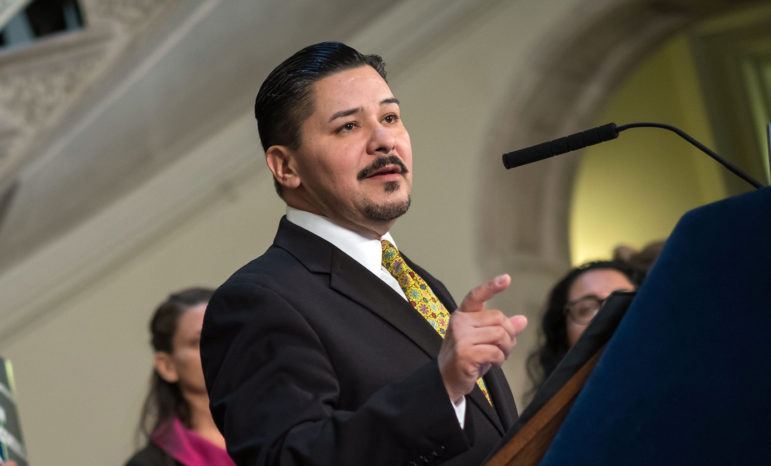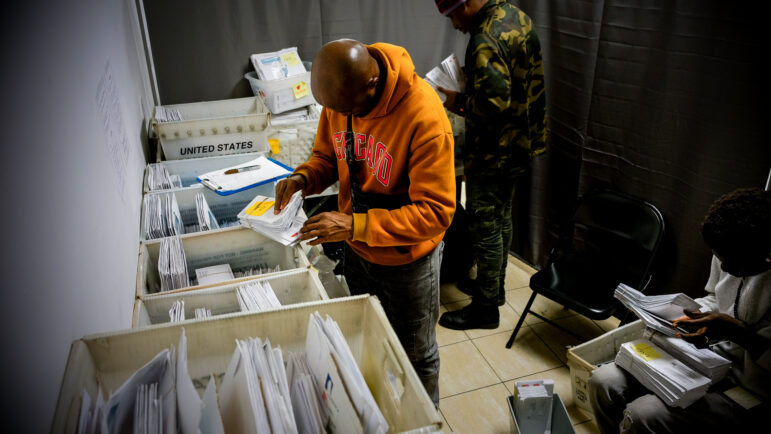
Ed Reed/Mayoral Photography Office
‘We applaud Chancellor Carranza for his bold leadership and vision in shouldering the decades-overdue task of integrating our public schools.’
In June 2017, the New York City Department of Education (DOE) convened the School Diversity Advisory Group (SDAG) to address the extreme segregation of the New York City school system. A year later, following extensive collaboration among advocates, students, and policy experts, we, the New York City Alliance for School Integration and Desegregation (nycASID), offered the SDAG a robust policy platform for dismantling segregation, built upon the framework developed by the students of IntegrateNYC . In February 2019, the SDAG released its initial report and recommendations. This June, the DOE announced that it would adopt most of these recommendations as proposed.
We applaud Chancellor Carranza for his bold leadership and vision in shouldering the decades-overdue task of integrating our public schools and breaking down the barriers that have systematically excluded children of color from educational opportunities. However, while the DOE’s initial plans are encouraging, they fall short of what’s needed to dismantle the entrenched segregation in our schools. We are especially concerned that the DOE did not adopt crucial enrollment policy recommendations, but instead replaced them with weaker language that dilutes their potential. To achieve meaningful desegregation, ambitious enrollment targets must be coupled with accountability for progress and an overhaul of discriminatory admissions screening and processes.To help our partners and the public hold the DOE accountable, we’ve published a point-by-point review of the DOE’s response to each of the SDAG’s individual recommendations, as well as an analysis of the policy implications of these responses. Most of the SDAG’s recommendations are not about enrollment policies, but instead address a wide range of factors that interact with enrollment patterns to produce separate and unequal schooling. To its credit, the DOE has agreed to adopt almost all of these recommendations, including correcting funding inequities and ensuring that schools in low-income neighborhoods offer the same academic and extracurricular opportunities as schools in wealthier neighborhoods. The DOE is also giving students a greater voice in changing the high school admissions process and other policy decisions.
The DOE further adopted many recommendations addressing structures in schools that often marginalize students of color, economically disadvantaged students, students with disabilities, and multi-language learners, thus undermining true integration even in apparently desegregated schools. These include implementing culturally responsive education in curriculum and teacher training, diversifying school staffing to more closely reflect the student population, engaging all parents more effectively, and reforming biased school discipline practices. In a notable exception, the DOE did not agree to consider taking over supervision of School Safety Agents from NYPD. However, the Mayor’s Office recently announced a multi-agency package of school climate and discipline initiatives that reflects other changes sought by advocates.
If implemented robustly, the measures adopted by the DOE can significantly improve our schools. However, these vital policy changes do not eliminate the need for concrete changes to enrollment practices, including admissions screens. It is concerning, therefore, that the DOE replaced many of the SDAG’s enrollment policy recommendations with weaker language that raises questions about accountability for necessary changes. So far, the DOE has been more willing to commit to improving schools where marginalized students are isolated than to take concrete steps towards large-scale desegregation.
For instance, the SDAG identified nine districts that it believes are diverse enough to achieve integration now, and recommended that all nine be “required” to develop integration plans. The DOE’s replacement language promises instead to “strongly support and encourage” these districts to develop such plans. Overall, the language adopted in place of the SDAG’s recommendations appears to delegate authority for enrollment policies to the community districts themselves. It is left unclear what will happen if districts are not able or willing to achieve meaningful progress towards integration.
In addition to raising concerns about accountability, delegating the work of integration to districts also inherently limits the progress that can be made, because district boundaries themselves contribute to segregation. Some district boundaries were originally motivated by redlining or self-segregation, and significant disparities among the districts remain today. Thus, nycASID’s platform calls for phasing in borough-wide integration planning, as well as potentially redrawing district boundaries or creating cross-district attendance zones. Although the DOE did agree that all schools should look more like the city in the long term, the language adopted omits the SDAG’s recommendation that schools should reflect their borough in the medium term. Furthermore, delegating authority for enrollment policies to districts could undermine work towards borough-wide and city-wide integration.
The DOE also rejected the call to create a new cabinet-level office with the authority to ensure progress towards integration, promising that the Chancellor would serve that function instead. Although we do not question Carranza’s commitment to equity, we are concerned that this choice will mean everyone and no one is responsible for integrating the city’s schools. We are also concerned that the DOE will focus exclusively on promoting integration within the nine districts highlighted by the SDAG, and will fail to hold other similar districts accountable for reducing disparities among the schools within their boundaries.
The current system of admissions screens, which often disproportionately excludes marginalized groups from elementary Gifted & Talented programs and selective middle and high schools, also requires a comprehensive overhaul. The SDAG will address these screens in a forthcoming report. The nycASID platform calls for the DOE to:
• Replace Gifted & Talented programs with inclusive enrichment programs;
• End the current model of middle school screening; and
• End discrimination in high school screening.
Many of the criteria currently used in admissions screens are susceptible to bias and measure family privilege as much as or more than academic potential. Not surprisingly, the result is often that the more selective the school, the fewer black, brown and high needs students it accepts.
The DOE must ensure that all admissions screens are designed to dismantle racial, ethnic and socio-economic isolation and ensure equitable access for all students, including multi-language learners and students with disabilities. Criteria used must be closely related to a clearly articulated and valid educational goal (such as language screens for dual language programs).
Get the best of City Limits news in your inbox.
Select any of our free weekly newsletters and stay informed on the latest policy-focused, independent news.
Finally, the DOE must radically simplify the high school admissions process overall. The time and resources that touring and applications currently demand mean that school choice itself often functions as an admissions screen based on family privilege.
The current moment represents a great opportunity to realize the potential of desegregation and integration. School desegregation is in the national spotlight, there’s a groundswell of activism among young people and their adult allies to demand real integration, and in New York City our Chancellor is leading the way by taking a strong stand for equity. We must seize this opportunity to enact broad and deep changes capable of creating real integration, including changes to student assignment policies at all levels of schooling. Without significant reform of the zoning, choice, and screening policies that have contributed to extreme racial and socio-economic isolation of children across the city’s schools, we will never achieve a truly integrated school system that provides, for all students, the equal and adequate education to which they are entitled.
Sarah Darby is a member of the Policy/Public Action Committee of nycASID and a graduate of the Education Policy master’s program at Teachers College. She has worked as a data specialist in schools in the South Bronx and East New York and has served as a consultant helping school districts to develop performance metrics. Miriam Nunberg is the co-chair of the Policy/Public Action Committee of nycASID. She is also a parent of two NYC public school students, and a co-founder of the Brooklyn Urban Garden Charter School and District 15 Parents for Middle School Equity. Additionally, she is a consultant and special education advocate, and a former attorney for the U.S. Department of Education’s Office for Civil Rights.









8 thoughts on “Opinion: DOE’s Desegregation Plans Offer Hope, Need Improvement”
NYC Public Schools are only about 15% white so forget about desegregating most schools.
NYCDOE demographic snapshot:
https://infohub.nyced.org/reports-and-policies/citywide-information-and-data/information-and-data-overview#jump-to-heading-25
I think you attached the wrong link
Go to that link and then click on ‘Demographic Snapshot’.
Thanks for writing all this BS. Carranza needs to be fired!!
You speak like someone whose never taught in the public schools! Based on the failure of blasio billion dollar renewal school program and mental health program, parents cannot have confidence in this “new and improved” plan. some doe schools function because of the community of minds acting on and shaping that school’s culture; they function despite the doe –not bc if it. Helping children — no matter their skin shade is requires the not-do-sexy work of teaching and learning– skills woefully underestimated. I imagine Eva Markowitz will be the new it-girl — where all the kids — no matter skin shade –will flee. That said, maybe Carranza had some jedi magic — though there is nothing in his background or his recent performance in nyc to suggest this. I’d be very nervous as a parent with these changes –given the track record. He couldn’t even roll out culturally responsive education with a Chinese interpreter — in Chinatown! A harbinger of things to come?
I’m concerned about who this will actually benefit and who the winners and losers will be. How about create great schools for all students and educate communities about acceptance? Some communities want segregation and that will be difficult to change. Schools need to be a safe place physically, socially and emotionally for all members. Administrators need to gain the trust of the communities and produce real results. There are always changes but nothing ever changes. I would like to see the entire Village roll up their sleeves. Inclusion of all students should be the focus and learning that there is a great big world out there where people of all different backgrounds work beside each other. Education is the key here.
nycASID adopted the integration framework laid out by InegrateNYC. This framework highlights 5 components that must be addressed to create true integration in New York City. These 5 components are colloquially referred to as the 5 R’s of real integration.
One of those Rs is Race and Enrollment. Also, it is important to note that the longstanding history of systemic and multi-faceted racial segregation in New York City (and other northern metropolitan areas) has not only resulted in vast school segregation along lines of race but has also led to the segregation of public school students along lines of socioeconomic status, ability, and language status.
Our specific suggestions in this arena are that within 3 years, all entry grades will reflect the demographics of their home districts, and all entry grades for city-wide programs, including high schools, will reflect the demographics of the City as a whole. Within 6 years, all entry grades will reflect the demographics of their home boroughs.
We also acknowledge the other R’s of real integration must be addressed to create truly integrated schools. These include:
-Resource schools through fair distribution and monitoring of resources and opportunities
-Relate through supportive relationships and culturally responsive curriculum and professional development for educators
-Restore through appropriate responses to conflict and justice that interrupt the school to prison pipeline
-Represent diverse community through school faculty and leaders that reflect the culture and identities of students and families
‘…and all entry grades for city-wide programs, including high schools, will reflect the demographics of the City as a whole…’
And just how will you accomplish that in the Bronx (4.3% white) and Staten Island (44.2% white)??